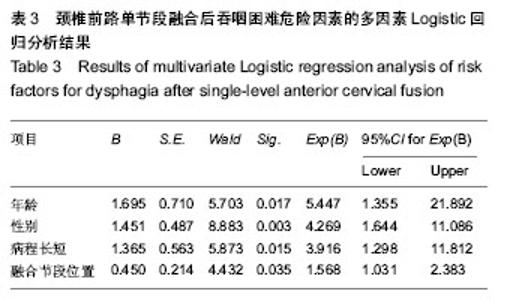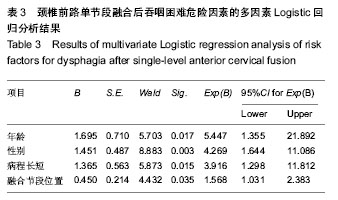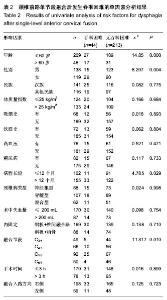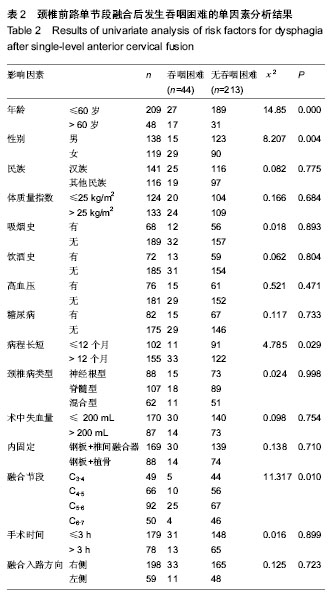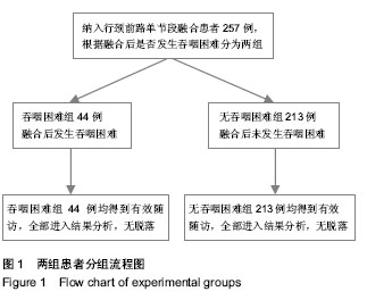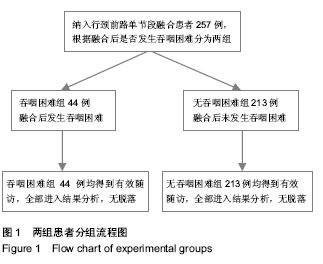| [1] Smith GW, Robinson RA. The treatment of certain cervical-spine disorders by anterior removal of the intervertebral disc and interbody fusion. J Bone Joint Surg Am. 1958; 40-A(3):607-624.
[2] Skeppholm M, Ingebro C, Olerud C,et al. The Dysphagia Short Questionnaire: an instrument for evaluation of dysphagia: a validation study with 12 months’follow-up after anterior cervical spine surgery. Spine (Phila Pa 1976). 2012; 37(11):996-1002.
[3] Kalb S, Reis MT, Cowperthwaite MC, et al. Dysphagia after anterior cervical spine surgery: incidence and risk factors. World Neurosurg. 2012;77(1):183-187.
[4] Buttermann GR. Prospective nonrandomized comparison of an allograft with bone morphogenic protein versus an iliac-crest autograft in anterior cervical discectomy and fusion. Spine J. 2008;8(3):426-435.
[5] Campbell PG, Yadla S, Malone J, et al. Early complications related to approach in cervical spine surgery: single-center prospective study. World Neurosurg. 2010;74(2-3): 363-368.
[6] Fehlings MG, Smith JS, Kopjar B, et al. Perioperative and delayed complications associated with the surgical treatment of Cervical Spondylotic Myelopathy based on 302 patients from the AOSpine North America cervical spondylotic myelopathy Study. J Neurosurg Spine. 2012;16(5):425-432.
[7] 祁敏,王新伟,袁文,等.三种颈前路减压术式治疗多节段脊髓型颈椎病的并发症比较[J]. 中国脊柱脊髓杂志,2012,22(11): 963-968.
[8] Daniels AH, Riew KD, Yoo JU, et al. Adverse events associated with anterior cervical spine surgery. J Am Acad Orthop Surg. 2008;16(12):729-738.
[9] Fountas KN, Kapsalaki EZ, Nikolakakos LG, et al. Anterior cervical discectomy and fusion associated complications. Spine.2007;32(21):2310-2317.
[10] Fehlings MG, Smith JS, Kopjar B, et al. Perioperative and delayed complications associated with the surgical treatment of Cervical Spondylotic Myelopathy based on 302 patients from the AOSpine North America cervical spondylotic myelopathy Study. J Neurosurg Spine. 2012;16(5):425-432.
[11] Riley LH 3rd , Vaccaro AR, Dettori JR, et al. Postoperative dysphagia in anterior cervical spine surgery. Spine. 2010;35(9 Suppl):S76-S85.
[12] Stewart M, Johnston RA, Stewart I, et al. Swallowing performance following anterior cervical spine surgery. Br J Neurosurg. 1995;9(5):605-609.
[13] Yue WM, Brodner E, Highland TR. Persistent swallowing and voice problems after anterior cervical discectomy and fusion with allograft and plating: a 5- to 11-year follow-up study. Eur Spine J. 2005;14(7):677-682.
[14] Tervonen H, Lauri ER, Back L, et al. Dysphonia and dysphagia after anterior cervical decompression. J Neurosurg Spine. 2007;7(2):124-130.
[15] Rihn JA, Kane J, Albert TJ, et al. What is the incidence and severity of dysphagia after anterior cervical surgery? Clin Orthop Relat Res. 2011;469(3):658-665.
[16] Bazaz R, Lee MJ, Yoo JU. Incidence of dysphagia after anterior cervical spine surgery: a prospective study. Spine. 2002;27(22): 2453-2458.
[17] Kang SS, Lee JS, Shin JK, et al. The association between psychiatric factors and the development of chronic dysphagia after anterior cervical spine surgery. Eur Spine J.2014;23(8): 1694-1698.
[18] Altman KW. Oropharyngeal dysphagia pathophysiology, complications, and science-based interventions. Nestle Nutr Inst Workshop Ser. 2012;72:119-126.
[19] Foley NC, Martin RE, Salter KL, et al. A review of the relationship between dysphagia and malnutrition following stroke. J Rehabil Med. 2009;41(9):707-713.
[20] Plowman-Prine EK, Sapienza CM, Okun MS, et al. The relationship between quality of life and swallowing in Parkinson’s disease. Mov Disord. 2009;24(9):1352-1358.
[21] Cichero JA, Altman KW. Definition, prevalence, and burden of oropharyngeal dysphagia: a serious problem among older adults worldwide and the impact on prognosis and hospital resources. Nestle Nutr Inst Workshop Ser. 2012; 72:1-11.
[22] Alvarez-Hernandez J, Planas Vila M, Leon-Sanz M, et al. Prevalence and costs of malnutrition in hospitalized patients: the PREDyCES study. Nutr Hosp. 2012;27(4):1049-1059.
[23] Semenov YR, Starmer HM, Gourin CG. The effect of pneumonia on short-term outcomes and cost of care after head and neck cancer surgery. Laryngoscope. 2012;122(9): 1994-2004.
[24] Starmer HM, Riley LH 3rd, Hillel AT, et al. Dysphagia, short-term outcomes, and cost of care after anterior cervical disc surgery. Dysphagia.2014;29(1):68-77.
[25] Singh K, Marquez-Lara A, Nandyala SV, et al. Incidence and Risk Factors for Dysphagia After Anterior Cervical Fusion. Spine.2013,38(21):1820-1825.
[26] Mehra S, Heineman TE, Cammisa FP, et al. Factors predictive of voice and swallowing outcomes after anterior approaches to the cervical spine. Otolaryngol Head and Neck Surg.2014,150(2):259-265.
[27] Anderson KK, Arnold PM. Oropharyngeal Dysphagia after Anterior Cervical Spine Surgery: A Review. Global Spine J.2013;3(4):273-286.
[28] Smith-Hammond CA, New KC, Pietrobon R, et al. Prospective analysis of incidence and risk factors of dysphagia in spine surgery patients: comparison of anterior cervical, posterior cervical, and lumbar procedures. Spine. 2004;29(13):1441-1446.
[29] Edwards CC 2nd, Karpitskaya Y, Cha C, et al. Accurate identification of adverse outcomes after cervical spine surgery. J Bone Joint Surg Am.2004; 86-A(2):251-256.
[30] Lee MJ, Bazaz R, Furey CG, et al. Risk factors for dysphagia after anterior cervical spine surgery: a 2-year prospective cohort study. Spine J. 2007;7(2):141-147.
[31] Ratnaraj J, Todorov A, McHugh T, et al. Effects of decreasing endotracheal tube cuff pressures during neck retraction for anterior cervical spine surgery. J Neurosurg.2002;97(2 Suppl): 176-179.
[32] Chin KR, Eiszner JR, Adams SB Jr. Role of plate thickness as a cause of dysphagia after anterior cervical fusion. Spine. 2007; 32(23):2585-2590.
[33] Riley LH 3rd, Skolasky RL, Albert TJ, et al. Dysphagia after anterior cervical decompression and fusion: prevalence and risk factors from a longitudinal cohort study. Spine.2005; 30(22): 2564-2569. |
